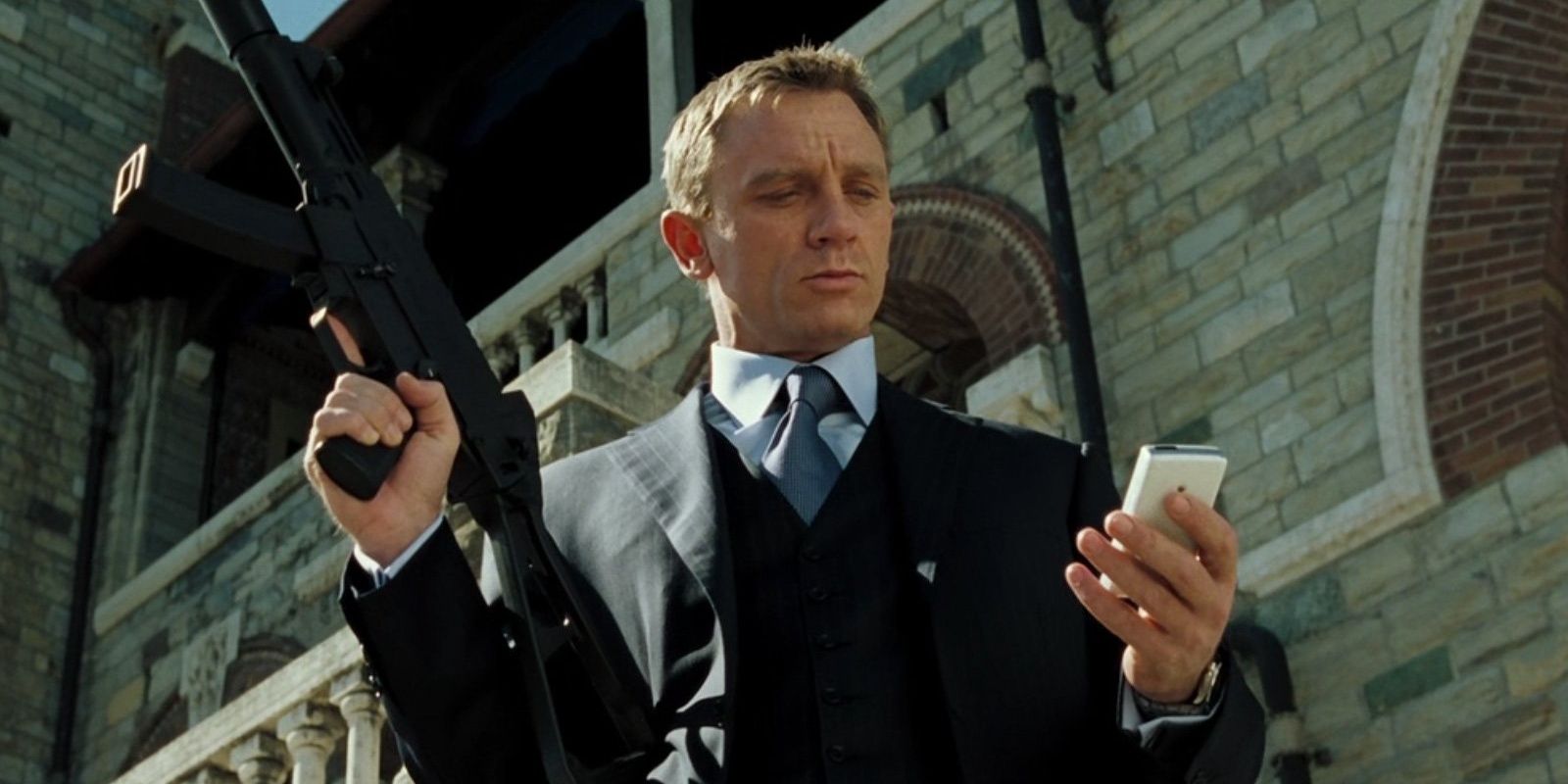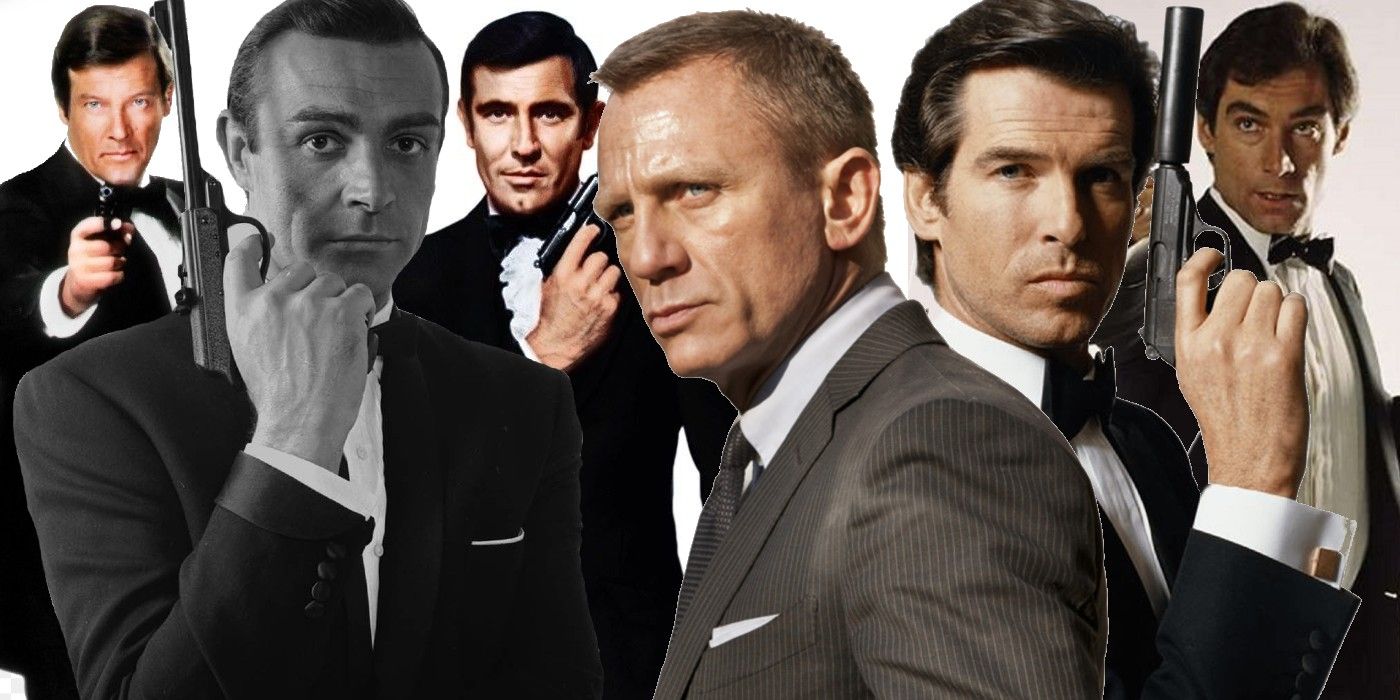
With No Time To Die already a blockbuster at the global box office, James Bond continues to be incredibly popular after 60 years. Created by Ian Fleming, who wrote 15 novels and several short stories about secret agent 007, James Bond was already well-known when EON Productions released the first Bond movie, Dr. No starring Sean Connery, in 1961. Since then, James Bond has become the longest-running movie franchise in history, and the British spy’s popularity continues unabated.
James Bond was conceived as a product of his era; the character was born in the 1950s from Ian Fleming’s experiences as a naval intelligence officer during World War II. When Sean Connery first played 007 in the 1960s, he was an idealized man of his time: suave, irresistible to the opposite sex, but also ruthless and unafraid to use his license to kill as he saw fit. Connery set the mold for all of the James Bond actors who followed him but each one added to the mythos and to the character. George Lazenby was more laid back than Connery while Roger Moore played up his comedic charms for his seven films as James Bond from 1973-1985. Timothy Dalton brought back Bond’s grit for the action hero era of the 1980s while Pierce Brosnan combined his predecessors into a fusion of wit, sophistication, and violence as a world-saving hero.
Daniel Craig’s tenure as James Bond elevated 007’s prestige to even greater heights. By playing Bond for 15 years, he’s the longest-serving actor in the role, and arguably the most popular since Sean Connery. Craig also redefined the role of James Bond by breaking from Connery’s mold while still honoring the character’s tropes. No Time To Die is Craig’s 007 swansong but the film is earning rave reviews and making bank at the box office despite being delayed several times due to the ongoing COVID-19 pandemic. It’s frankly amazing that James Bond continues to be so popular 60 years after he first debuted on movie screens. The James Bond fandom now spans generations and every James Bond actor is someone’s favorite 007. Yet beyond the suits, the martinis, the cars, the girls, and the action, there are deeper reasons why James Bond continues to be popular for the last 60 years, and likely for 60 more.

One of the most memorable moments in 1995’s GoldenEye was when the new M (Judi Dench) dressed down James Bond (Pierce Brosnan) and called him “a sexist, misogynist dinosaur… a relic of the Cold War.” By the 1990s, this was indeed the public image of James Bond, which GoldenEye called out immediately. Criticism has been levied at 007 since the character’s creation, that the spy is an immoral womanizer, an alcoholic, a gun-toting government lackey who is no hero, and just an empty suit.
However, James Bond has evolved through the decades and has been reinvented to suit each era and to fit the actor playing him. Sean Connery’s James Bond was the epitome of 1960s swagger and, frankly, sexism, although George Lazenby tried to give Bond some romantic sensitivity. Roger Moore made James Bond a hero for the outlandish 1970s, not taking things too seriously. Timothy Dalton ushered in a huge change for Bond in the 1980s where Bond stopped smoking cigarettes because it was now public knowledge that tobacco causes cancer, and Dalton also drastically reduced Bond’s womanizing. Pierce Brosnan then tried to bring back some of his predecessors’ excesses but he was very much an all-purpose action hero for the 1990s.
Daniel Craig’s James Bond found his incredible success by being different, and not just because Craig has blond hair. While Craig’s 007 still drank vodka martinis and romances beautiful Bond Girls, his James Bond was a secret agent for today, a hero who would do whatever it took to do what’s right regardless of the personal cost. As each of his films proved, Craig’s 007 had the most well-rounded internal life, has suffered love and loss, and his movies delved into his origin so that audiences had a greater understanding of what makes James Bond tick than ever before.

With Daniel Craig’s first Bond movie, Casino Royale, 007’s producers took a huge gamble by delivering a total reboot of the Bond movie franchise, but it paid off royally. Casino Royale was a completely new beginning that severed ties with the loose but sprawling canon established by the Bond movies that began with Sean Connery and ended with Pierce Brosnan’s 2002 Die Another Day. Instead, Casino Royale, with its black and white, ultraviolent opening sequence that showed Craig’s 007 earning his license to kill, ushered in a completely new era for James Bond that was phenomenally successful.
The fact that Craig’s James Bond had his own continuity saved his version of 007 and his movies. Audiences were free to discover James Bond all over again, and newer fans didn’t have to worry about catching up on 20 prior movies to understand the secret agent and his adventures. Meanwhile, older Bond fans could revel in the changes Craig brought to the super spy while still maintaining the key tropes that make him James Bond. Craig’s five Bond movies also embraced serialization, which is so popular in the Peak TV era, so that all of his films, from Casino Royale to No Time To Die, told a complete story about Craig’s James Bond, with a definitive ending. As a result, Daniel Craig’s James Bond canon comfortably exists alongside the original 007 continuity so that every Bond fan can enjoy each version of 007 without fretting over retcons or violations of established canon.

Daniel Craig’s James Bond movies were also an ideal fusion of 007 nostalgia with modern moviemaking. When fans think of James Bond, they visualize a perfectly tailored suit, a Walther PPK handgun, a vodka martini, and an Aston Martin DB5. Ingeniously, instead of arriving fully-formed, Craig’s Bond movies had 007 gradually earn all of his classic tropes, thereby making the old new again. For example, in Casino Royale, audiences got to see Bond invent his favorite martini, which he named after his love, Vesper Lynd (Eva Green). By Skyfall, a new M (Ralph Fiennes), Miss Moneypenny (Naomie Harris), and Q (Ben Whishaw) were introduced, completing Bond’s classic supporting cast. 2015’s Spectre even rebooted Bond’s classic enemy, Ernst Stavro Blofeld (Christoph Waltz), and made their rivalry personal.
Every return or reinvention of James Bond’s classic tropes helped make Craig’s 007 movies feel more and more like the ultimate Bond, and audiences responded, not just with ticket sales but with a desire to mimic the Bond lifestyle. Craig’s James Bond movies largely wiped away the negative stigma around 007 that he was a “misogynist dinosaur.” Craig simply made 007 cool again, to men, women, and kids. All of this translated to Craig’s Bond becoming a global sensation at the box office, while EON Productions’ careful management of the 007 brand kept it from being diluted.

One of the greatest masterstrokes of James Bond’s popularity is the incredibly careful and successful casting choices of each James Bond actor. Sean Connery was so perfect as Ian Fleming’s master spy brought to life that he remains the standard all others are judged, but every Bond actor was ideal in his own way. George Lazenby had difficulty filling Connery’s shoes but decades later, his lone 007 film, 1969’s On Her Majesty’s Secret Service, has been reconsidered and is now heralded as a top-level Bond film. Roger Moore’s reinvention of 007 for the 1970s was wildly successful while Timothy Dalton brought Bond closer to Ian Fleming’s original character and Pierce Brosnan’s dashing and bold 007 was a huge hit in the 1990s. While they are all very different actors, they each made James Bond their own and contributed to 007’s iconic status.
To be sure, Daniel Craig’s success is instrumental in maintaining James Bond’s popularity in the 21st century. Craig’s films brought 007 into modern times and continuously deliver awe-inspiring action and spectacle, while Craig’s version of Bond has a deeper, conflicted inner life that audiences connect with and leads James to rise to heroism time and again. Craig’s British spy is immensely popular with both male and female audiences and, for this generation, Daniel Craig has become the definitive James Bond. The next actor to succeed Daniel Craig in the role after No Time To Die will certainly have a tough act to follow but, as 007 history has proven, James Bond will continue to evolve with the times and his popularity will likely continue for another 60 years.
